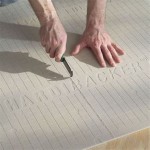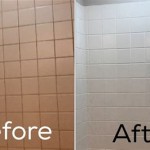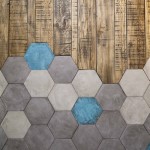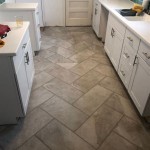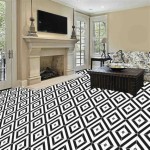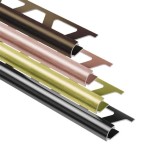The Versatility Of Small Hexagon Tiles
Small hexagon tiles, typically ranging in size from one to three inches, have experienced a significant resurgence in popularity in the design world. Once relegated to vintage bathrooms and neglected kitchens, these geometric wonders are now finding application in a wide array of residential and commercial spaces. Their resurgence is largely attributed to their inherent versatility, enabling them to adapt to various design styles, blend seamlessly with diverse materials, and offer virtually limitless possibilities for creative expression.
The appeal of small hexagon tiles extends beyond mere aesthetics. They represent a practical flooring and wall covering solution, offering durability, ease of maintenance, and a unique visual texture that can elevate the perceived value of any space. Moreover, advancements in manufacturing techniques have led to a broader range of materials, colors, and finishes, further enhancing their adaptability to specific design requirements and budgetary constraints. From classic ceramic to modern porcelain, and from natural stone to vibrant glass, the options for small hexagon tiles are extensive and continuously evolving.
Adaptability to Diverse Design Aesthetics
One of the primary reasons for the widespread adoption of small hexagon tiles is their inherent adaptability to diverse design aesthetics. Whether the desired outcome is a minimalist contemporary space or a richly textured traditional interior, these tiles can be seamlessly integrated into the overall design scheme. In modern environments, monochromatic or subtly patterned hexagon tiles create a clean and sophisticated look. These tiles can be paired with streamlined fixtures and minimalist furniture to enhance the sense of spaciousness and order. The uniform geometric pattern provides a subtle visual interest without overwhelming the space.
Conversely, in traditional or vintage-inspired settings, small hexagon tiles can be used to evoke a sense of historical authenticity and charm. The use of classic color combinations, such as black and white mosaics, or the incorporation of intricate patterns, replicates the look and feel of traditional tilework. These tiles can be complemented with antique-style fixtures, ornate moldings, and rich color palettes to create a cohesive and inviting atmosphere. The small size of the tiles allows for the creation of intricate and detailed patterns that would be difficult or impossible to achieve with larger formats.
Furthermore, small hexagon tiles are frequently employed in transitional designs, bridging the gap between traditional and contemporary styles. By blending classic patterns with modern materials and color palettes, designers can create spaces that are both timeless and stylish. For example, a neutral-toned hexagon tile floor paired with contemporary cabinetry and traditional hardware can create a balanced and harmonious interior. The versatility of these tiles lies in their ability to complement and enhance a wide range of design elements, making them a valuable asset in the creation of personalized and visually appealing spaces.
Material Diversity and Performance Characteristics
The versatility of small hexagon tiles is further underscored by the wide range of materials from which they are manufactured. Each material offers distinct performance characteristics and aesthetic qualities, allowing designers to select the most appropriate option for a given application. Ceramic tiles, being a classic and economical choice, are known for their durability, water resistance, and ease of maintenance. They are suitable for both wall and floor applications in residential and light commercial settings. Porcelain tiles, a denser and more durable alternative, offer enhanced stain resistance and water impermeability, making them ideal for high-traffic areas and wet environments. Their superior performance characteristics make them a popular choice for both interior and exterior applications.
Natural stone hexagon tiles, such as marble, granite, and travertine, offer a luxurious and organic aesthetic. Each stone possesses unique veining and color variations, adding depth and character to any space. While natural stone tiles require regular sealing and maintenance to prevent staining and etching, their timeless beauty and inherent durability make them a worthwhile investment. These tiles are often used in high-end residential and commercial projects where a sophisticated and elegant ambiance is desired.
Glass hexagon tiles provide a vibrant and modern aesthetic. Available in a wide range of colors and finishes, including translucent, opaque, and iridescent options, glass tiles can create a visually striking effect. They are particularly well-suited for accent walls, backsplashes, and decorative borders. While glass tiles may be more prone to scratching than other materials, their non-porous surface makes them resistant to staining and mold growth. Moreover, the reflective properties of glass can enhance the brightness and perceived spaciousness of a room.
Beyond these common materials, small hexagon tiles are also available in specialized options such as metal, concrete, and recycled materials. Metal tiles, often made from stainless steel or copper, add a touch of industrial chic to any space. Concrete tiles offer a raw and textured aesthetic, perfect for urban and contemporary designs. Recycled tiles, made from reclaimed glass or other materials, provide an eco-friendly and sustainable flooring or wall covering solution. The wide array of material options ensures that there is a small hexagon tile to suit virtually any design style and performance requirement.
Creative Applications and Design Possibilities
The inherent geometric shape of small hexagon tiles allows for a multitude of creative applications and design possibilities. Beyond their traditional use as floor and wall coverings, these tiles can be used to create intricate patterns, accent borders, and personalized mosaics. The small size of the tiles allows for greater flexibility in design, enabling the creation of complex and visually appealing arrangements. One popular application is the creation of gradient patterns, where tiles of varying shades are used to create a smooth transition between colors. This technique can be used to add depth and dimension to a space, or to create a focal point on a wall or floor.
Another creative application involves the use of contrasting colors to create bold and graphic patterns. Geometric shapes, such as chevrons, stripes, and diamonds, can be easily achieved using small hexagon tiles. These patterns can be used to define zones within a room, to add visual interest to a plain surface, or to create a sense of movement and energy. The use of contrasting grout colors can further enhance the visual impact of these patterns.
Small hexagon tiles are also frequently used to create custom mosaics. By combining tiles of different colors, materials, and finishes, designers can create unique and personalized artworks. These mosaics can depict abstract designs, representational images, or intricate patterns. The small size of the tiles allows for a high level of detail and precision, resulting in stunning and one-of-a-kind creations. Mosaics can be used as focal points in entryways, bathrooms, or kitchens, adding a touch of artistry and individuality to the space.
Furthermore, small hexagon tiles can be used to create seamless transitions between different flooring materials. For example, a hexagon tile floor can be used to transition from a hardwood floor to a carpeted area, creating a visually appealing and functional separation. The geometric shape of the tiles allows for a smooth and gradual transition, avoiding abrupt changes in flooring texture and height. This technique is particularly useful in open-plan living spaces, where it can help to define different areas without the need for walls or partitions.
The versatility of small hexagon tiles extends beyond interior applications. They can also be used in outdoor spaces, such as patios, balconies, and swimming pools. Exterior-grade hexagon tiles are available in materials that are resistant to frost, moisture, and UV radiation, ensuring their durability and longevity in harsh weather conditions. These tiles can be used to create decorative pathways, outdoor kitchens, and poolside mosaics, adding a touch of elegance and sophistication to any outdoor setting.
In conclusion, the resurgence of small hexagon tiles is a testament to their enduring appeal and remarkable versatility. Their ability to adapt to diverse design aesthetics, their wide range of material options, and their potential for creative applications make them a valuable asset in the design of residential and commercial spaces. As design trends continue to evolve, small hexagon tiles are likely to remain a popular and timeless choice for designers and homeowners alike.

Grey Mosaics Effect Tile In A Honed Finish European Heritage

Hexagonal Tiles Why Should You Choose This Style Trend Hyperion

Hexagonal Tiles Why Should You Choose This Style Trend Hyperion

The Pros And Cons Of Hexagon Tiles For Your Bathroom Kitchen

Creating Dynamic Interiors With Hexagon Tiles

Size Versatility And Aesthetic Freedom The Allure Of Small Ceramic Tiles

Grey Mosaics Effect Tile In A Finish European Heritage

Hexagon Tile The Shape Of Things To Come St Louis Company

Best Hexagon Floor Tiles Innovative Ways To Use

The Many Exciting Angles Of Hexagon Tile
Related Posts


